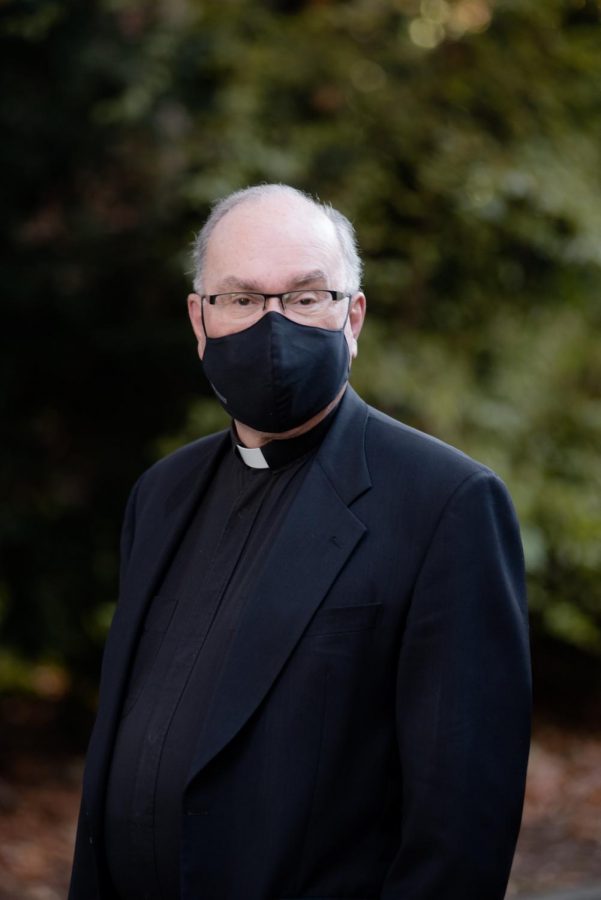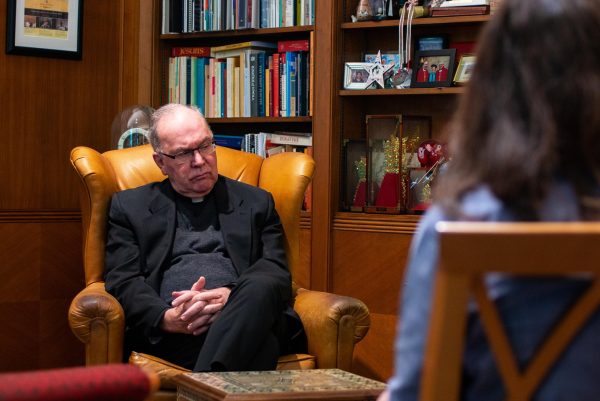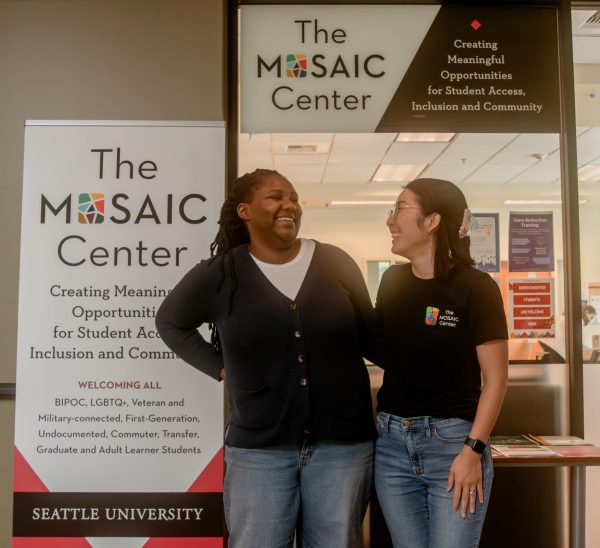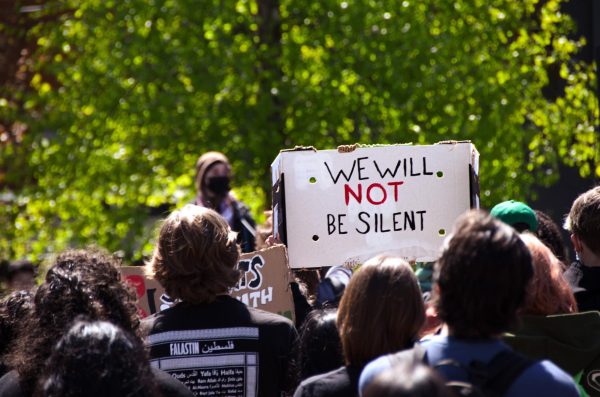Seattle University Reflects Upon the Legacy of Outgoing President Stephen V. Sundborg S.J.
President Stephen V. Sundborg, S.J. has been a focus of the Seattle University community for over two decades. As he prepares to hand over the baton to new leadership, students, administrators and staff are reflecting upon his legacy. While living in a humble room in the Arrupe Jesuit residence, Sundborg dramatically changed the landscape of Seattle U’s campus and oversaw significant expansions of university programs. The accomplishments and controversies of the Sundborg era have shaped the Seattle U of today and are worth reflecting upon as President Elect Peñalver prepares to assume presidency in July of 2021.
While president at Seattle U, Sundborg has compiled a list of accomplishments including technological innovation, enhanced campus spirituality and the university’s overall reputation.
Seattle U’s facilities and academic programs have greatly improved throughout Sundborg’s presidency. David Powers, the Dean of the College of Arts and Sciences, commented on these developments.
“Just looking at the buildings, it’s clear that [Seattle U] has grown in a very physical way,” Powers said. “With the law school right when [Sundborg] first got here, the Eisiminger Fitness Center, the library, the Center for Science and Innovation and the Lee Center, there’s been a lot of growth.”
When Sundborg first entered office, the campus was nowhere near its current grandeur. Fr. John Topel, the Jesuit Assistant to the Law School Dean, worked alongside Sundborg and watched the university expand before his eyes.
“The campus was about half finished when Father Sundborg took over, and it’s about 95% finished now,” Topel said. “He’s done a really remarkable job of building it—building endowment, raising money and raising the level of visibility of the university.”
In addition to the campus’ physical expansion, many new programs have been established while old ones were reinforced under Sundborg’s leadership.
“We’ve had several new programs start since [Sundborg’s] been here,” Powers said. “He’s supported the development of the film studies program, the fine arts leadership program, kinesiology and the LGBTQ+ minor.”
In implementing these changes, Sundborg has also enhanced the university’s public image.
“Under [Sundborg’s] leadership, we’ve moved from a regional university to a national university that is now categorized by the Carnegie foundation as a professional doctoral institution,” Seattle U Provost Shane Martin said.
Seattle U’s heightened visibility can also be attributed to its athletic growth. During Sundborg’s time at Seattle U, the university transitioned from a DIII to a DI school.
Mark Markuly, the Dean of the School of Theology and Ministry, witnessed the development of Seattle U’s reputation under Sundorg.
“I think Fr. Steve brings his Jesuit background into discernment and decision processes and all aspects of the way he leads,” Markuly said. “He’s a very pastoral president; He’s caring, warm and kind…He takes individual meetings of students, faculty and staff that many presidents would not prioritize in their schedule…I think that all comes from his Jesuit background and experience.”
As an individual who has spent the majority of his life in the Society of Jesus, Sundborg emphasized his legacy within the Jesuit community and beyond at Seattle U.
“People will not think, ‘He was the president, he was kind of above us in this big job,’ but ‘He was a member of our community,’” Sundborg said. “I think that does something for the legacy of the Jesuit community.”
Sundborg said his greatest achievement has been the establishment of a mission, which Martin attested to.
“During his tenure, our mission statement and core values were updated, refined and enhanced,” Martin said. “When you look at the stated mission, there’s a lot of important things in there: the dedication to lifelong learning and professional formation, which is distinctive in terms of other Jesuit universities.”
Since his inauguration, Sundborg has also been proactive in establishing a solid foundation for the university’s Jesuit community.
“When he came to Seattle U, he constantly stressed the Jesuit identity and tried to establish its foundation,” Fr. Topel said. “He established things like the institute of Catholic thought and culture and the Jesuit educational mission process, headed by Joe Orlando, the Arrupe seminars—all those things were under his time.”
President Sundborg opened the School of Theology and Ministry during his time at Seattle U. According to Markuly, the school is slated to close in three years, largely due to the decreased number of students who are interested in pursuing a master’s degree in Theology.
“The school started the first day he was president. So there’s a book end historically, in a sense,” Markuly said.
The School of Theology and Ministry closure is also indicative of current times. As Seattle U welcomes its first non-religious president, the university ends a chapter of significant Jesuit presence. Despite this change, faculty claims attest to the fact that Seattle U could not be in a better position to withstand the shift.
One contentious issue the president faced in the past two decades involved the divergence in values between the school’s generally socially and politically liberal population and the catechism of the Catholic church.
In April 2018, President Sundborg drew fire from LGBTQ+ student groups after The Spectator featured a photo from an on-campus drag performance.
In Sept. 2019, students protested after the president removed a Planned Parenthood link from the university website after a letter from a rightwing national student group. Reflecting on these controversies, Sundborg stated that he should have listened more in hindsight.
“I wish I had listened more and acted and spoke only after I had listened more deeply. I tend to be a person who can quickly articulate my mind when something comes up. So whether it was about the cover of The Spectator and my reaction to it, or it was about Planned Parenthood, you can get trapped in a quick reaction,” Sundborg said.
Despite Sundborg’s empathy for student frustrations and his goal to create “an inclusively Catholic university,” he still reinforces his decisions in certain scenarios as the President of a Catholic institution with a responsibility to uphold the church’s social teachings.
“Another meaning of being inclusively Catholic as president of a Catholic university is taking a stance on unpopular issues. The Catholic Church stands for certain things, and I don’t get to choose what those are. If I’m the president of a Catholic university, I need to stand for those positions that the Catholic Church chooses, and that will draw criticism and controversy,” Sundborg said.
While Peñalver’s presidency will usher in a new perspective at Seattle U, Sundborg’s legacy has become a vital part of the institution—with or without his physical presence.
“Father Sundborg has prepared SU for this moment in the way he’s led in an inclusive and open manner that has created an environment at SU that’s supportive of a range of leaders and backgrounds,” Martin said. “Seattle U is welcoming and inclusive of multiple religious backgrounds, including those who don’t have a religious background…In that regard, he’s built the foundation for the first late president to be very successful.”
Vice President and Chief Financial Officer Wilson Garone also attested to his experiences working with the president. In the 2019-2020 academic year, Seattle U spent at a $5.9 million deficit. Garone attributed the problem to a small endowment for the size of the university, and expressed appreciation for Sundborg’s efforts to rectify the spending gap, empowering Garone to take a dynamic approach to Seattle U’s budget.
“I don’t think I could have started that financial repositioning without [Sundborg’s] support,” Garone said.
Garone attributed various bold decisions to the leadership of Sundborg in uniting the Jesuit mission of the university with its financial decisions.
Throughout his tenure, President Sundborg has led efforts to diversify Seattle U’s student body through financial opportunities for disenfranchised populations. In 2000, the university joined the Costco Scholars program with the University of Washington to offer scholarship opportunities for underrepresented student populations. Sundborg recalled what he heard from scholars after the program began, taking note of ownership and an overall sense of community.
“They said, ‘I feel like this is my university, I feel like I can be myself here. I feel like I’m at home here.’ It was a very important statement and these were African American, Hispanic or Native American students. Just that sense of belonging was a key dimension around what those scholarships make possible,” Sundborg said.
When asked what impact or message he would like to leave Seattle U with, Sundborg underscored gratitude for both himself and the student body.
“I always say that the thing I want most of all in graduates of Seattle U is that they live their lives with gratitude. That’s certainly where I am,” Sundborg said. “I’m already missing the people of Seattle U, and I’ve got eight more months to go, so it’s going to be a long time of missing people— but I’m realizing how much I’ve been gifted over these years.”











